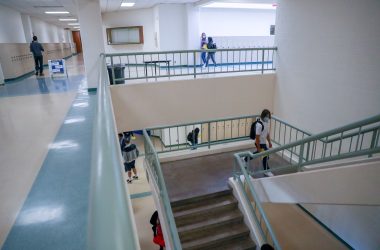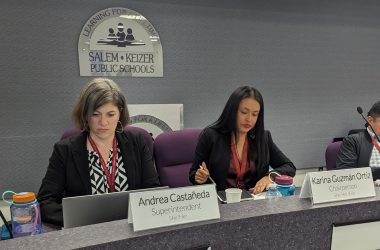 Students get off the bus for the first day of school at Bush Elementary. (Rachel Alexander/Salem Reporter)
Students get off the bus for the first day of school at Bush Elementary. (Rachel Alexander/Salem Reporter)
About 400 fewer Salem-Keizer students passed the state’s English test last year than in the previous year, according to state data released Thursday.
The data shows a small districtwide decrease in the number of students meeting state standards in both English and math. About 10,000 local students took the English test, and 7,000 took the math.
Of those, about half of Salem-Keizer students tested showed they met the state’s benchmark for English, and about one in three for math.
[ Help build Salem Reporter and local news – SUBSCRIBE ]
Salem-Keizer isn’t alone. Across Oregon, the number of students passing English and math dropped. That was true of nearly every large school district in the state, including Portland, Beaverton, North Clackamas, Bend-La Pine and Eugene.
In Salem-Keizer, the number of students meeting standards has decreased every year since Oregon began using the Smarter Balanced tests during the 2014-15 school year.
District leaders were disappointed in the new results.
“We were hoping for more gains than we saw,” said Assistant Superintendent Kraig Sproles. “They’re pretty static, which is not good and frustrating.”
(Graphic by Rachel Alexander/Salem Reporter)
Local schools varied in how their students did. Some improved the number of students passing by as much as 10%, while others saw decreases.
There was good news in the test results. Third-graders across the district performed better than last year in both subjects.
“We are making some progress and there are bright spots throughout the data but we’re nowhere near where we need to be and we realize that,” Sproles said. “These aren’t scores that we’re standing on and saying ‘We’ve arrived.’”
Here are some takeaways from the 2018-19 data.
1. By the time they graduate, Salem-Keizer students beat the Oregon average.
When they’re first tested in third grade, Salem-Keizer students perform worse than the state average, and far below Portland and Beaverton students.
That doesn’t surprise school officials. The district has a higher poverty rate than the state average, and more students learning English as a second language than any other district in Oregon. On average, local students heading into kindergarten recognize fewer letters and sounds than their peers across the state.
In third grade, about one-third of Salem-Keizer students meet English standards, compared with over half in Portland and 47% statewide.
But by 11th grade, Salem-Keizer high-schoolers do slightly better. In math, 35% pass the test versus 32% in Oregon. In English, 68% pass versus 67% statewide.
2. Math scores are up in third and fourth grade after a new curriculum was introduced.
After falling last year, the number of third and fourth graders meeting math standards is back up. About 37% of third-graders met state standards in 2018-19: that’s about 50 more kids across the district than the previous year.
Last year, Salem-Keizer went districtwide with a new math curriculum. The district has also worked to identify kids who struggle with math in elementary school and pull them aside for extra help.
“Those two things probably did make a difference and I hope that we continue with that upward trend,” Sproles said.
3. But math remains a challenge.
In English, Salem-Keizer students improve year-over-year. More fourth graders pass the test than third graders, and so on through high school.
But in math, the trajectory is less clear. Fourth and fifth graders perform worse than third graders, suggesting kids aren’t making progress at grade level once they’re in school. That drop continues into middle school before reversing.
Even then, more third graders pass the test than high school juniors. That’s true statewide.
4. Third grade reading improved slightly, with big gains at some schools.
Learning to read by third grade is an important benchmark for students. Nationally, a child who can read in third grade is four times more likely to graduate high school than one who can’t, and Salem-Keizer administrators track the number closely.
About 50 more kids hit that bar in 2018-19 than the prior year. It’s a small increase, but some schools performed far better.
Washington Elementary School went from just 13% of third-graders meeting standards in third grade to 31% last year. Myers Elementary School saw a similar jump from 29% to 51%.
Those outliers are useful for administrators because they suggest schools to zero in on.
“What’s going on there and how can we replicate that?” Sproles said.
5. District leaders expect gains in reading scores in coming years.
Over the past three years, Salem-Keizer has stepped up efforts to improve elementary school reading by focusing on skills like letter and sound recognition for kindergarten and first graders.
Those lessons were in about half of district elementary schools two years ago, and this is the first year where every kindergarten and first-grade classroom will have the lessons.
Sproles said district tests are showing reading improvement for students who go through those lessons, but it’s too early for that to appear in state results.
“Unfortunately, those kids are this year’s third graders,” Sproles said.
Reporter Rachel Alexander: [email protected] or 503-575-1241.

Rachel Alexander is Salem Reporter’s managing editor. She joined Salem Reporter when it was founded in 2018 and covers city news, education, nonprofits and a little bit of everything else. She’s been a journalist in Oregon and Washington for a decade. Outside of work, she’s a skater and board member with Salem’s Cherry City Roller Derby and can often be found with her nose buried in a book.









